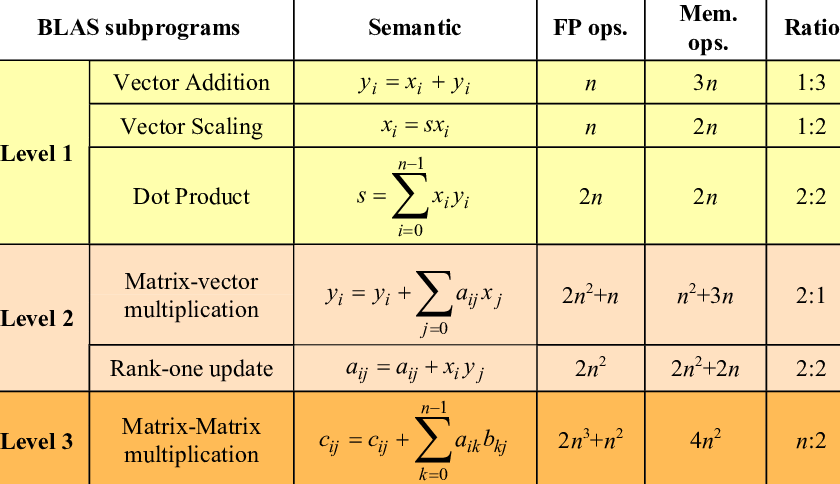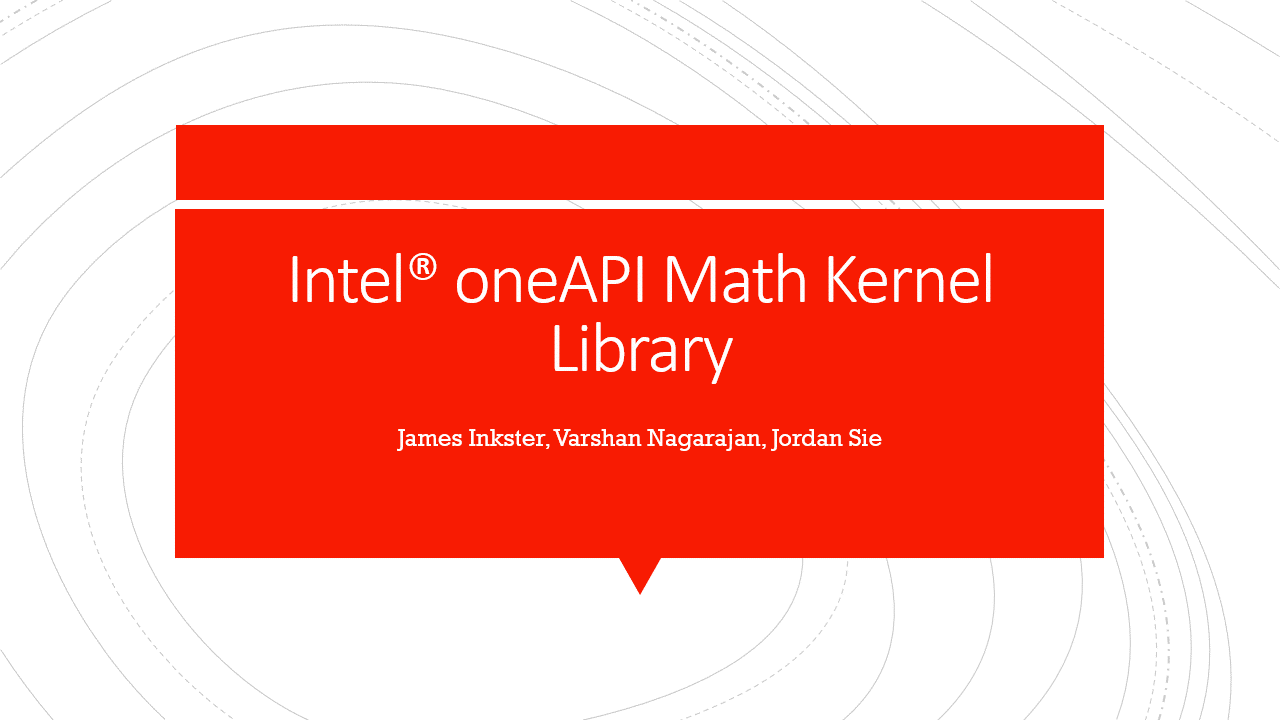DPS921/Intel Math Kernel Library
GPU621/DPS921 | Participants | Groups and Projects | Resources | Glossary
Contents
Intel Math Kernel Library
Team Name
Slightly Above Average
Group Members
- Jordan Sie
- James Inkster
- Varshan Nagarajan
Progress
100%/100%
Intel Math Library
Introduction
The Intel oneAPI Math Kernel Library (MKL) is the fastest and most widely used math library for all intel based systems. It helps you reach high performance with its enhanced library of optimized math routines. It allows for faster math processing times, increased performance and shorter development times. The MKL supports seven main features; Linear Algebra, Sparse Linear Algebra, Data Fitting, Fast Fourier Transformations, Random Number Generation, Summary Statistics and Vector Math. These features will allow you to optimize applications for all current and future intel CPUs and GPUs.
Features
Linear Algebra
Intel has implemented linear algebra functions that follow industry standards ([BLAS](http://www.netlib.org/blas/) and [LAPACK](http://www.netlib.org/lapack/)). These functions include those that can do the following:
Level 1: Vector-vector operations
Level 2: Matrix-vector operations
Level 3: Matrix-matrix operations
There are many different implementations of these subprograms available. These different implementations are created with different purposes or platforms in mind. Intel's oneAPI implementation heavily focuses on performance, specifically with x86 and x64 in mind.
Sparse Linear Algebra Functions
Able to perform low-level inspector-executor routines on sparse matrices, such as:
- Multiply sparse matrix with dense vector
- Multiply sparse matrix with dense matrix
- Solve linear systems with triangular sparse matrices
- Solve linear systems with general sparse matrices
A sparse matrix is matrix that is mostly empty, these are common in machine learning applications. Using standard linear algebra functions would lead to poor performance and would require greater amounts of storage. Specially written sparse linear algebra functions have better performance and can better compress matrices to save space.
Fast Fourier Transforms
Enabling technology today such as most digital communications, audio compression, image compression, satellite tv, FFT is at the heart of it. A fast Fourier transform (FFT) is an algorithm that computes the discrete Fourier transform (DFT) of a sequence, or its inverse (IDFT).
Random Number Generator
The Intel Math Kernel Library has an interface for RNG routines that use pseudorandom, quasi-random, and non-deterministic generators. These routines are developed the calls to the highly optimized Basic Random Number Generators (BRNGs). All BRNGs differentiate in speeds and properties so its easy to find a optimized one for your application.
All RNG routines can be categorized in several different categories.
- Engines - hold the state of a generator
- Transformation classes - holds different types of statistical distribution
- Generate function - the routine that obtains the random number from the statistical distribution
- Services - using routines that can modify the state of the engine
The generation of numbers is done in 2 steps:
1. generate the state using the engine.
2. iterate over the values and the output is the random numbers.
Data Fitting
The Intel Math Kernal Library provide spline-based interpolation that can be ultilized to approximate functions for derivatives, integrals and cell search operations.
Data Fitting routines use the following workflow to process a task:
- Create a task or multiple tasks
- Modify the task parameters
- Perform a Data Fitting computation
- Destroy the task or tasks
Data Fitting functions:
- Task Creation and Initialization Routines
- Task Configuration Routines
- Computational Routines
- Task Destructors
Summary Statistics
The Intel Math Kernal Library has an interface for Summary Statistics that can compute estimates for single, double and multi-dimensional datasets. For example, such parameters may be precision, dimensions of user data, the matrix of the observations, or shapes of data arrays. First you create and intialize the object for the dataset, then you call the summary statistics routine to calculate the estimate.
Summary Statistics calculate:
- Raw and central sums/moments up to the fourth order.
- Variation coefficient.
- Skewness and excess kurtosis.
- Minimum and maximum.
Additional Features:
- Detect outliers in datasets.
- Support missing values in datasets.
- Parameterize correlation matrices.
- Compute quantiles for streaming data.
Vector Math
There are two main set of functions for the Vector Math library that the intel MKL uses they are:
- VM Mathematical Functions Which allows for it to compute values of mathematical functions e.g. sine, cosine, exponential, or logarithm on vectors that are stored in contiguous memory.
- VM Service Functions are used for showing when catching errors made in the calculations or accuracy. Such as catching error codes or error messages from improper calculations.
Code Samples
These samples are directly from the Intel Math Kernal Library code examples. All our code examples were taken from the github intel library located at One API Github
Vector Add & MatMul
The two samples we included in our presentation are specifically located at Mat Mul and Vector-add located at the links provided.
Conclusion
The Intel oneAPI Math Kernel Library is available from the oneAPI base toolkit and it supports programming languages like C, C++, C#, DPC++ and Fortran. These features will help any financial, science or engineering applications run at an optimized level. The MKL is constantly updated on the Intel oneAPI website with lots of examples and tutorials available on their github. If there's any questions, feel free to ask us or refer to the Intel oneAPI website.
Presentation
Animated GIF of the Presentation
PDF File:
[File:https://wiki.cdot.senecacollege.ca/w/imgs/Intel_Math_Kernel_Library.pdf]



